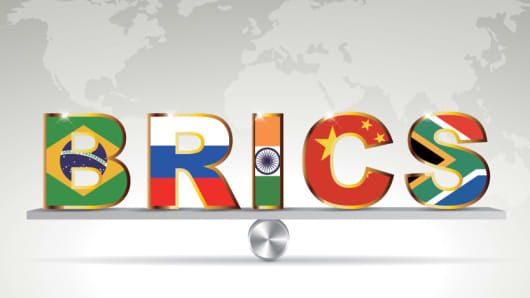BRICS may sound like something you use to build a house, but they're the initials of some very important countries with economies that affect the world.
So what countries make up the BRICS? How did the term come about? What impact do the BRICS have? CNBC explains.
What are the BRICS?
BRIC are the letters that originally stood for these countries: Brazil, Russia, India and China.
South Africa became part of the BRIC nations in 2010, turning BRIC into BRICS.
Actually, the BRICS were first formed on paper rather than as a real group. Here's how it started.
The acronym has been attributed to Goldman Sachs chief economist Jim O'Neill in a 2001 paper he wrote called, "Building Better Global Economic BRICs."
In his paper, O'Neill argued that since the four BRIC countries were developing rapidly, by 2050 their combined economies could eclipse all the economies of the richest countries in the world.
The BRICS acronym has come to be used as a symbol of the shift in global economic power away from the developed G7 economies—like the U.S.—and toward the developing world.
The five nations if combined would be the largest entity on the global stage, according to Goldman Sachs, which has continued to monitor the four countries since 2001. They are considered among the biggest and fastest growing emerging markets, or those markets still developing.
Many analysts consider the BRICS a good place for investment because of their growing populations, infrastructure building, and expansive middle class.
Are the BRICS a true economic bloc?
The Goldman Sachs theory isn't that these countries are a political alliance—like the European Union—but that they have the potential to become a powerful economic bloc.
Currently, there are no reported formal agreements among all the five countries. But there have been agreements between some of the BRICs.
Those agreements include the Shanghai Cooperation Organization between Russia and China, which includes India as an observer. There's also the IBSA Trilateral Forum, in which Brazil, India, and South Africa take part in annual talks.
There are some indications that the BRICS are trying to actually organize themselves as a group. On June 16, 2009, the leaders of the BRIC countries held their first summit in Russia,and issued a declaration calling for the establishment of an "equitable, democratic and multipolar world order."
Since then they have met in Brazil in 2010 and in China in 2011.
What makes the BRIC countries powerful?
The BRICS have a lot going for them. These countries encompass over 25% of the world's land coverage and 40% of the world's population and hold a combined gross domestic product or GDP of 18.5 trillion dollars, according to recent statistics.
Brazil's resources include massive amounts of oil, along with large supplies of agricultural products. Russia, too, has great repositories of oil, along with coal and natural gas. India has iron ore, bauxite, and copper ore and is one of the major producers of iron in the world.
South Africa is the largest energy producer and consumer on the African continent. In addition to diamonds and gold, the country also has reserves of iron ore, platinum, manganese, chromium, copper, uranium, silver, beryllium, and titanium.
China has coal, iron ore, petroleum, natural gas, mercury, rare earth elements, uranium, and the world's largest potential for hydropower.
China is currently the world’s largest exporter. India has 10 of the 30 fastest-growing urban areas in the world and could see 700 million people move to cities by 2050, according to Goldman Sachs—which means greater demand for goods and services by India's population and faster economic growth.
The BRICS theory from Goldman believes that China will become the world's biggest supplier of manufactured goods, India will become the world's dominant supplier of services, while Brazil and Russia will become dominant as suppliers of raw materials.
Of the five BRIC countries, China is said to have the strongest economy, which is actually larger than that of the four other BRIC economies combined.
Will the BRICS expand?
There has been speculationthat South Korea and Mexico will become additions to the BRICS.
They were not included in Jim O'Neill's original paper in 2001, because they looked to be more developed nations and economies than Brazil, Russian India, and China, according to O'Neill. Neither country has officially tried to join.
Indonesia has said it might want to be part of the BRICS at some time in the future.
Are the BRICS a true economic force?
To many observers and investors, the BRIC countries are merely five separate emerging markets with little in common. They are countries developing their economies—with a high pay off, but also with high risks.
The risks include fears that all five could fail to live up to their economic potential. There are political concerns over human right issues in China and Russia that could keep out future investors and slow their economic growth.
Looking at India, its troubled past with Pakistan could limit government finances, increase social unrest, and limit potential domestic economic demand.
Brazil is said to just be getting some economic growth back after years of limited or negative growth, and slowing foreign investing.
And South Africa has a mixed economy with a very high rate of poverty and low GDP per capita.
Nonetheless, whatever the concerns, the BRICS are drawing large amounts of attention and money. A recent reportsaid the BRICS were leading the world in attracting global investments, as of May 2011.



